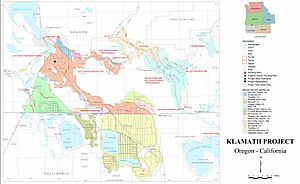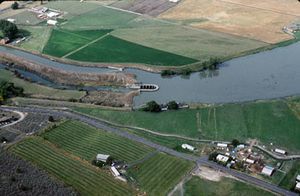Klamath Project facts for kids
The Klamath Project is a big water management system in the Klamath Basin. It was built by the United States Bureau of Reclamation to help farmers get water for their crops. It also provides water to important wildlife areas like the Tule Lake National Wildlife Refuge and the Lower Klamath National Wildlife Refuge. This project was one of the first big projects built by the U.S. government to manage water.
The main water sources for the project are Upper Klamath Lake and the Klamath River. Other important water bodies in the project include Clear Lake Reservoir, Link River, Lost River, Lower Klamath Lake, and Tule Lake. The project collects water from melting snow and spring rains, usually in March and April. This water fills up the reservoirs and also stops old marshlands from flooding, which are now used as farmland.
About 225,000 acres (91,000 hectares) of rangeland have been turned into active farmland because of the Klamath Project. A large part of this, about 80,000 acres (32,000 hectares), was created by draining a section of Lower Klamath Lake. This lake is a shallow marsh that sits on the border between Oregon and California. Tule Lake was also made smaller by moving water from the Lost River into the Klamath River.
Farmers in the project grow crops like barley, alfalfa hay, oats, potatoes, and wheat. The Klamath Basin is also a major stop on the Pacific Flyway, which is a route for birds migrating. Many different types of birds visit the Klamath Basin National Wildlife Refuges Complex every year.
It's important not to mix up the Klamath Project with the Klamath River Hydroelectric Project. That project involves several dams on the Klamath River that make electricity for a company called PacifiCorp. The Link River Dam is part of both projects.
Contents
A Look at the Klamath Project's Past
Building the Klamath Project started in 1906 with the "A" Canal. This main canal first delivered water on May 22, 1907. Other parts of the project were built over the next few years:
- The Clear Lake Dam was finished in 1910.
- The Lost River Diversion Dam and many other water delivery structures were completed in 1912.
- The Anderson-Rose Diversion Dam was finished in 1921.
- The Malone Diversion Dam on the Lost River was built in 1923 to send water to Langell Valley.
In 1917, a company called California-Oregon Power Company (now Pacific Power) made a deal with the U.S. government. They were allowed to build the Link River Dam. This dam helped both the Klamath Project and the power company. It also gave farmers in the Klamath Project special lower rates for electricity. The dam was completed in 1921.
Challenges and Changes Over Time
More recently, the Klamath Project has faced big disagreements. In 1988, two types of fish, the Lost River and Shortnose suckers, were listed as endangered. This, along with worries about salmon, led to a decision on April 6, 2001, to stop giving irrigation water to local farmers. This caused many protests from farmers and others.
The next year, the decision was changed. A report in 2002 by the National Research Council said that stopping the water in 2001 wasn't fully supported by science. They also found that a large salmon die-off in 2002 was caused by natural conditions like low water and high temperatures. These conditions led to a disease that affected the salmon.
The disagreements about balancing the needs of the economy (farmers) and the environment (fish and wildlife) have continued. A book called River of Renewal: Myth and History in the Klamath Basin (2006) explored these issues. Even today, there are still strong feelings on different sides of this topic.
How the Klamath Project Works
The Klamath Project is a big engineering effort. It uses dams, canals, and pumps to move and manage water.
Dams: Controlling Water Flow
The Klamath Project has seven dams. All of them are on rivers that flow into the Klamath River. Here they are, in the order they were finished:
- The Clear Lake Dam was completed in 1910 (and replaced in 2002). It helps control floods and stores water. It holds back the Lost River to create Clear Lake Reservoir.
- The Lost River Diversion Dam was finished in 1912. It moves water from the Lost River into the Klamath River. This helps control water levels in the Tule Lake National Wildlife Refuge and parts of the old Tule Lake bed that are now farmland.
- The Link River Dam was completed in 1921. It helps with flood control, stores water, and makes electricity. It holds back the Link River to form Upper Klamath Lake.
- The Anderson-Rose Diversion Dam was finished in 1921. It's a dam on the Lost River near Merrill, Oregon, that helps move water.
- The Malone Diversion Dam was finished in 1923. It's on the upper part of the Lost River.
- The Miller Diversion Dam was completed in 1924. It's on Miller Creek, about 8 miles (13 km) below Gerber Dam.
- The Gerber Dam was finished in 1925. It stores water by holding back Miller Creek to create Gerber Reservoir.
Canals: Moving Water Across the Land
The Klamath Project has over 717 miles (1,154 km) of canals, smaller channels, and diversion paths. These canals carry irrigation water from Klamath Lake, the Klamath River, Clear Lake, the Lost River, and Tule Lake. There are also two tunnels:
- The "A" Canal, which is the main canal, has an underground section as it goes through Klamath Falls.
- The Tule Lake Tunnel.
The project also has almost 728 miles (1,172 km) of drainage canals. These canals help drain land that would naturally be wetlands, making it possible to farm there. For example, Lower Klamath Lake used to be 80,000 acres (32,000 hectares) before it was drained. It would naturally lose a lot of water each summer, about the same amount of water that the "A" Canal delivers in a year.
Pumps: Lifting Water Where Needed
There are 28 pumping stations in the Klamath Project. These pumps can move a lot of water, more than 1,937 cubic feet per second (55 cubic meters per second) in total.
Managing Water in the Klamath Basin
The dams of the Klamath Project are owned by the government and are used for irrigation. However, there are also seven dams of the Klamath River Hydroelectric Project that are run by a private energy company, PacifiCorp. Both systems share the Link River Dam. This dam is owned by the United States Bureau of Reclamation but is operated by PacifiCorp. PacifiCorp uses it mainly to control its own water supply for making power, and secondarily for generating electricity.
Since 2001, there have been many disagreements about how water is managed in the entire Klamath River system. In 2001, a court order stopped irrigation water from going to Klamath Project farmers. This was done to keep enough water in the river for threatened Coho salmon and endangered Lost River Suckers. Coho salmon in this area are considered threatened.
In 2010, many groups signed an agreement called the Klamath Basin Restoration Agreement (KBRA). This legal agreement helps decide how water is used and who has rights to it in the Klamath River, the Klamath Project, and the Klamath Basin in California and Oregon. Important groups that signed this agreement included the Governors of California and Oregon, and the leader of the Klamath Tribes.
Goals of the Restoration Agreement
The Klamath Basin Restoration Agreement aims to:
- Help restore the natural areas along many rivers in the Klamath Basin.
- Remove four dams on the Klamath River that are run by PacifiCorp by 2020. The goal is to help salmon populations recover.
- Make sure that farmers in the Klamath Basin have enough water for irrigation.
- Provide the Klamath Tribes with a large piece of land called the Mazama Tree Farm, which is 90,000 acres (36,000 hectares).




